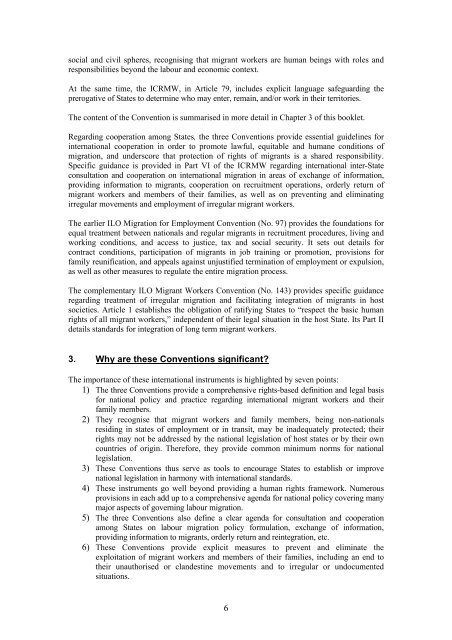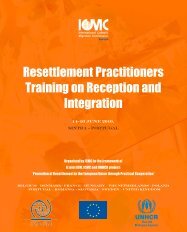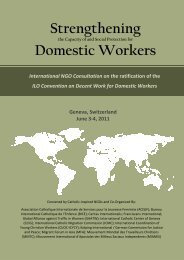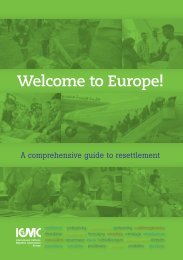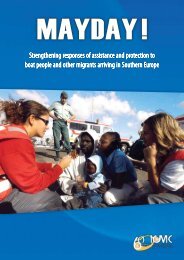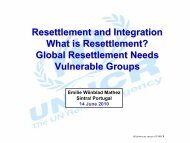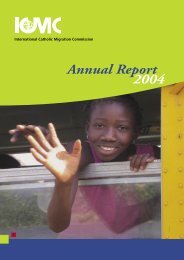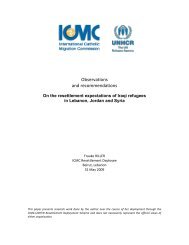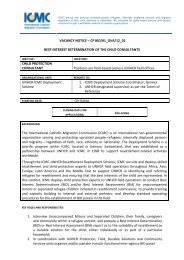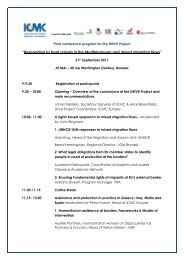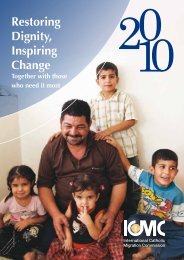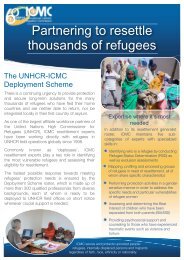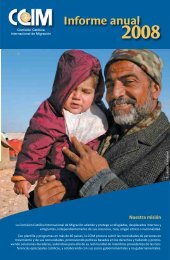Guide on ratification of the Migrant Workers Convention
Guide on ratification of the Migrant Workers Convention
Guide on ratification of the Migrant Workers Convention
Create successful ePaper yourself
Turn your PDF publications into a flip-book with our unique Google optimized e-Paper software.
social and civil spheres, recognising that migrant workers are human beings with roles and<br />
resp<strong>on</strong>sibilities bey<strong>on</strong>d <strong>the</strong> labour and ec<strong>on</strong>omic c<strong>on</strong>text.<br />
At <strong>the</strong> same time, <strong>the</strong> ICRMW, in Article 79, includes explicit language safeguarding <strong>the</strong><br />
prerogative <strong>of</strong> States to determine who may enter, remain, and/or work in <strong>the</strong>ir territories.<br />
The c<strong>on</strong>tent <strong>of</strong> <strong>the</strong> C<strong>on</strong>venti<strong>on</strong> is summarised in more detail in Chapter 3 <strong>of</strong> this booklet.<br />
Regarding cooperati<strong>on</strong> am<strong>on</strong>g States, <strong>the</strong> three C<strong>on</strong>venti<strong>on</strong>s provide essential guidelines for<br />
internati<strong>on</strong>al cooperati<strong>on</strong> in order to promote lawful, equitable and humane c<strong>on</strong>diti<strong>on</strong>s <strong>of</strong><br />
migrati<strong>on</strong>, and underscore that protecti<strong>on</strong> <strong>of</strong> rights <strong>of</strong> migrants is a shared resp<strong>on</strong>sibility.<br />
Specific guidance is provided in Part VI <strong>of</strong> <strong>the</strong> ICRMW regarding internati<strong>on</strong>al inter-State<br />
c<strong>on</strong>sultati<strong>on</strong> and cooperati<strong>on</strong> <strong>on</strong> internati<strong>on</strong>al migrati<strong>on</strong> in areas <strong>of</strong> exchange <strong>of</strong> informati<strong>on</strong>,<br />
providing informati<strong>on</strong> to migrants, cooperati<strong>on</strong> <strong>on</strong> recruitment operati<strong>on</strong>s, orderly return <strong>of</strong><br />
migrant workers and members <strong>of</strong> <strong>the</strong>ir families, as well as <strong>on</strong> preventing and eliminating<br />
irregular movements and employment <strong>of</strong> irregular migrant workers.<br />
The earlier ILO Migrati<strong>on</strong> for Employment C<strong>on</strong>venti<strong>on</strong> (No. 97) provides <strong>the</strong> foundati<strong>on</strong>s for<br />
equal treatment between nati<strong>on</strong>als and regular migrants in recruitment procedures, living and<br />
working c<strong>on</strong>diti<strong>on</strong>s, and access to justice, tax and social security. It sets out details for<br />
c<strong>on</strong>tract c<strong>on</strong>diti<strong>on</strong>s, participati<strong>on</strong> <strong>of</strong> migrants in job training or promoti<strong>on</strong>, provisi<strong>on</strong>s for<br />
family reunificati<strong>on</strong>, and appeals against unjustified terminati<strong>on</strong> <strong>of</strong> employment or expulsi<strong>on</strong>,<br />
as well as o<strong>the</strong>r measures to regulate <strong>the</strong> entire migrati<strong>on</strong> process.<br />
The complementary ILO <strong>Migrant</strong> <strong>Workers</strong> C<strong>on</strong>venti<strong>on</strong> (No. 143) provides specific guidance<br />
regarding treatment <strong>of</strong> irregular migrati<strong>on</strong> and facilitating integrati<strong>on</strong> <strong>of</strong> migrants in host<br />
societies. Article 1 establishes <strong>the</strong> obligati<strong>on</strong> <strong>of</strong> ratifying States to “respect <strong>the</strong> basic human<br />
rights <strong>of</strong> all migrant workers,” independent <strong>of</strong> <strong>the</strong>ir legal situati<strong>on</strong> in <strong>the</strong> host State. Its Part II<br />
details standards for integrati<strong>on</strong> <strong>of</strong> l<strong>on</strong>g term migrant workers.<br />
3. Why are <strong>the</strong>se C<strong>on</strong>venti<strong>on</strong>s significant?<br />
The importance <strong>of</strong> <strong>the</strong>se internati<strong>on</strong>al instruments is highlighted by seven points:<br />
1) The three C<strong>on</strong>venti<strong>on</strong>s provide a comprehensive rights-based definiti<strong>on</strong> and legal basis<br />
for nati<strong>on</strong>al policy and practice regarding internati<strong>on</strong>al migrant workers and <strong>the</strong>ir<br />
family members.<br />
2) They recognise that migrant workers and family members, being n<strong>on</strong>-nati<strong>on</strong>als<br />
residing in states <strong>of</strong> employment or in transit, may be inadequately protected; <strong>the</strong>ir<br />
rights may not be addressed by <strong>the</strong> nati<strong>on</strong>al legislati<strong>on</strong> <strong>of</strong> host states or by <strong>the</strong>ir own<br />
countries <strong>of</strong> origin. Therefore, <strong>the</strong>y provide comm<strong>on</strong> minimum norms for nati<strong>on</strong>al<br />
legislati<strong>on</strong>.<br />
3) These C<strong>on</strong>venti<strong>on</strong>s thus serve as tools to encourage States to establish or improve<br />
nati<strong>on</strong>al legislati<strong>on</strong> in harm<strong>on</strong>y with internati<strong>on</strong>al standards.<br />
4) These instruments go well bey<strong>on</strong>d providing a human rights framework. Numerous<br />
provisi<strong>on</strong>s in each add up to a comprehensive agenda for nati<strong>on</strong>al policy covering many<br />
major aspects <strong>of</strong> governing labour migrati<strong>on</strong>.<br />
5) The three C<strong>on</strong>venti<strong>on</strong>s also define a clear agenda for c<strong>on</strong>sultati<strong>on</strong> and cooperati<strong>on</strong><br />
am<strong>on</strong>g States <strong>on</strong> labour migrati<strong>on</strong> policy formulati<strong>on</strong>, exchange <strong>of</strong> informati<strong>on</strong>,<br />
providing informati<strong>on</strong> to migrants, orderly return and reintegrati<strong>on</strong>, etc.<br />
6) These C<strong>on</strong>venti<strong>on</strong>s provide explicit measures to prevent and eliminate <strong>the</strong><br />
exploitati<strong>on</strong> <strong>of</strong> migrant workers and members <strong>of</strong> <strong>the</strong>ir families, including an end to<br />
<strong>the</strong>ir unauthorised or clandestine movements and to irregular or undocumented<br />
situati<strong>on</strong>s.<br />
6


